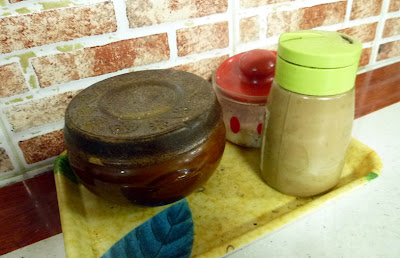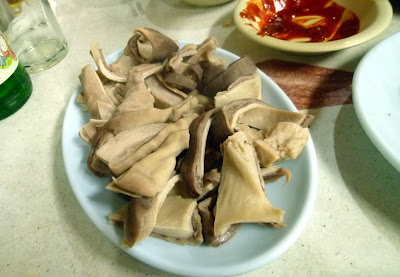The hair is removed from pigs' feet and they are thoroughly washed. Leeks, garlic, ginger, cheongju (rice wine) and water are brought to a boil. The pigs' feet are added, brought back to a boil and then simmered until tender. Then additional water, sugar and soy sauce are poured into the pot and the contents are slowly stirred. Once the jokbal is fully cooked, bones are removed, and the meat is cut into thick slices. It is then served with fermented shrimp sauce called saeujeot (새우젓)
One of my friends is crazy about jok bal. So, i usually go out to eat jok bal with her about once a month.
this time, i would show a popular jok bal restaurant. Have a look at this. :-)
the owner of this restaurant said, "Our jok bal sells so well, how fast we make it, it sells right away we have to cook jok bal again & again for customers"
cuts jok bal so hard & quickly
the restaurant is full with people, they are absorbed in eating jok bal
there are several dishs except for jok bal.
they are something like saurces to eat sundaeguk (similar with the pork stew)
several side dishes to eat with jok bal & sundaeguk
lettuce to wrap jok bal
Main dish "jok bal~~~~" looks so delicious?
lots of sesame is on jok bal
if you look them closely, you can find lots of ground pepper
it tastes smooth and rich and chewy
sundaeguk
Sundae (Korean pronunciation: [sundɛ], also sometimes spelled soondae) : The most common type of sundae is made of pig's intestines stuffed with cellophane noodles (dangmyeon), barley, and pork blood, although some variants also contain perilla leaves, scallions (pa), fermented soybean paste (doenjang), glutinous rice, kimchi, and soybean sprouts. It is a popular street food in North Korea and South Korea. In fact, there is a neighborhood called Sundae Town in Sillim-dong that has many restaurants dedicated to sundae.one of the parts of pork. people call this Osori gamtu





















No comments:
Post a Comment